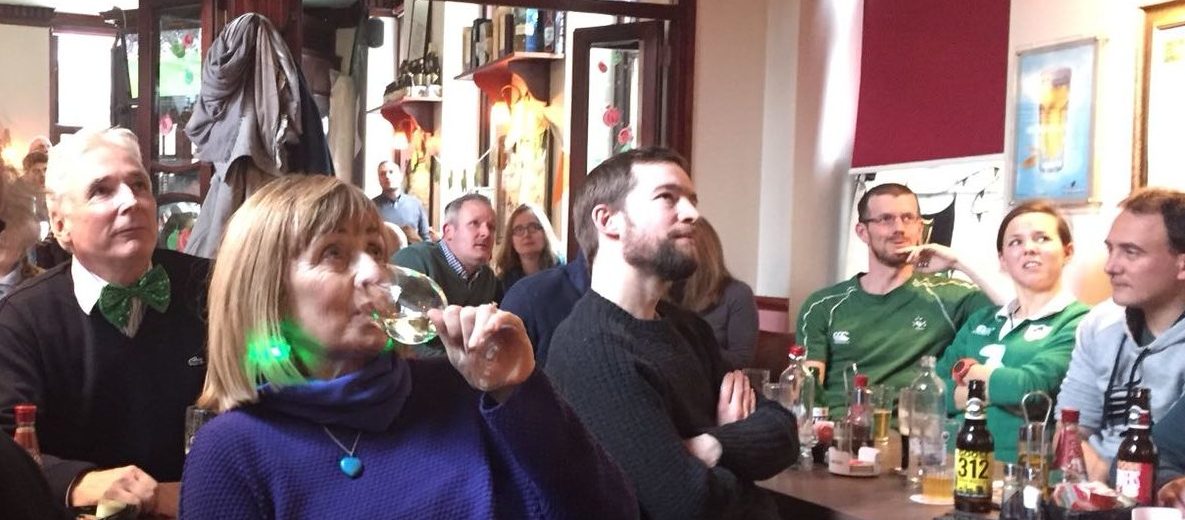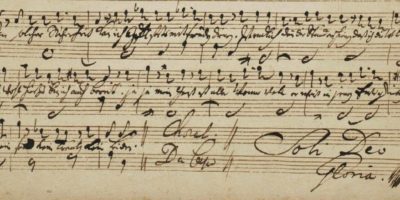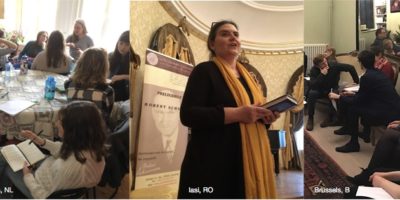Saturday was St Patrick’s Day. And it was a great day for the Irish. Green-clad fans crammed into Irish pubs everywhere to watch their national rugby team play England in the final match of the Six Nations Rugby Championship.
Although Ireland had already clinched the championship the week before, England was desperate to redeem their reputation after two defeats in a row, and to deny Ireland the honour of winning a Grand Slam.
Kitty O’Shea’s, the Irish pub opposite the European Commission building in Brussels, was no exception. After the first European Studies Course session just down the road in the Schuman Salon, I walked into the pub just as a roar went up to celebrate the first of what would become three tries – and a convincing win.
Leaving at half-time to catch my train back to Amsterdam, I glanced at the EU buildings towering above the Schuman station in the heart of the European district. Would there even have been a European Union, or a Europe as we know it today, without a St Patrick? I mused.
Perhaps all Europeans ought to be grateful for the spiritual tidal wave that swept eastwards from what Patrick himself understood to be ‘the ends of the earth’: his adopted home of Ireland. For, as we had traced earlier that day during the study course, that tsunami had swept through Britain, across to what is now France, the Low Countries and Germany, and continued into Switzerland and over the Alps to northern Italy.
Few on Saturday would have raised their Guinness to the spiritual revolution Patrick’s mission sparked in AD432, transforming an island of pagans into ‘the island of saints and scholars’. But it’s worth taking a moment to reflect on what Europe might have looked like without the Christian Celtic influence that started with Patrick.
Scholarship
The title of Thomas Cahill’s popular book, How the Irish saved civilization, boldly claims that the conversion of the Irish had huge consequences for western society after the collapse of the Roman empire and the subsequent loss of classical knowledge.
The monastic communities the Celts established, first in Ireland, then Scotland, followed by England and across onto the continent, became centres of learning, culture and scholarship, and libraries were established where surviving manuscripts were painstakingly copied. Monasteries became the storehouses of the great works of western literature.
The Irish were the first to separate words on the printed page, invent lower case letters and devise paragraphs. They produced the magnificent Book of Kells, the Book of Durrow and many other masterpieces. Illustrations included cats, mice, birds and others animals in a playful, almost irreverent, sense of humour. Mixing Christian and Celtic motifs, the manuscripts unite the beauty of both cultures, reflecting Patrick’s genius to enhance rather than obliterate the pre-Christian culture.
Cahill points out that historians often focus on the classical or medieval periods but forget the vital Celtic link between the two: ‘Without the mission of the Irish monks, who single-handedly refounded European civilisation throughout the continent in the bays and valleys of their exile, the world that came after them would have been an entirely different one–a world without books. And our own world would never have come to be.’
Patrick’s bold mission to Ireland was followed by outreaches by Columba to Iona and the Scots; Aidan, Chad and others to Lindisfarne and the English; Columbanus and Gallus to France, Austria, Switzerland and Italy; and Magnus to southern Germany, to name a few. The mission momentum continued after the Celtic Church was assimilated into the Roman Church in the 7th century, with Willibrord reaching out to the Friesians and Boniface to the German Saxons.
(By the way, you can still join remaining sessions of the European Studies Course in both Amsterdam and Brussels.)
Shamrock
This summer, Romkje and I will again take a group of modern pilgrims on the Celtic Heritage Tour, June 30-July 12, tracing Patrick’s footsteps and learn more about the influence of the Irish Celts and others who shaped Ireland, Britain and Europe through their faith. (The tour is nearly full but we hope to offer it again in 2020 and the Continental Heritage Tour next year.)
Lastly, what’s with the green? You wouldn’t need to ask that if you had ever been to the Emerald Isle where the rainy climate keeps the vegetation lush. And there’s the three-leafed shamrock, the sacred plant of the druids proudly displayed on the rugby jerseys of the new Six Nations champions, and by which Patrick is supposed to have illustrated the concept of the Trinity.
Whether he actually did or not doesn’t matter to the Irish. So long as it’s a good story.
Till next week,



